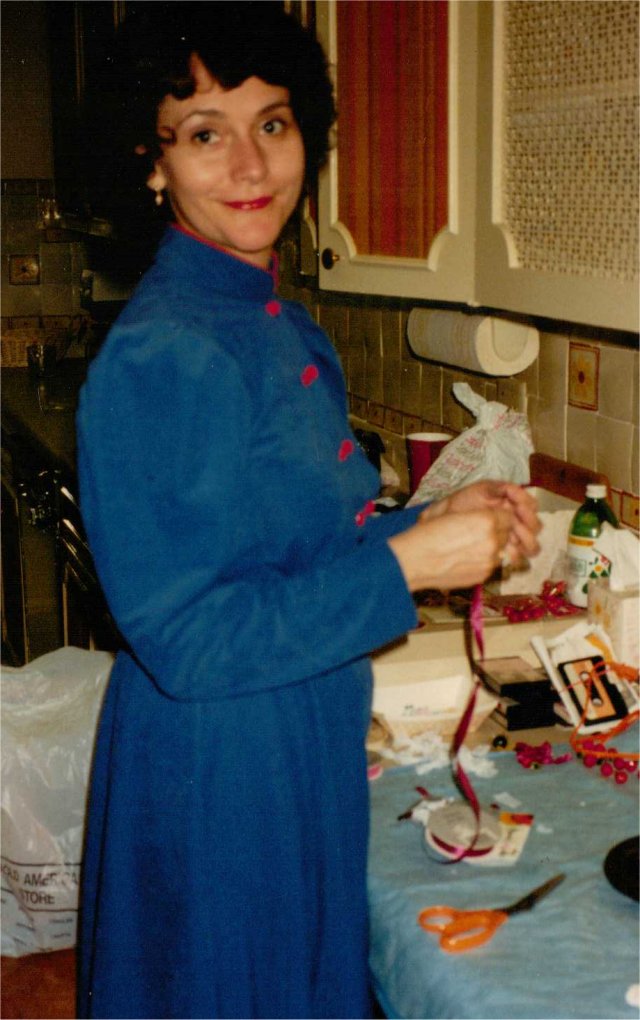
Photograph Set
1 About Erika's Spinal Cord Stimulator Installed in May 2016
Bob Jensen at
Trinity University

Erika is my wife. She's also a mother and, for
25 years, Erika was very happy with her medical career helping surgeons in
operating rooms
Her specialty was setting up instrument tables and handing surgeons instruments
called for during surgeries --- she likes to watch reruns of
MASH
In the early1970s while trying to lift a 200+ lb instrument table over a power cord
she herniated two discs in her lower spine
She was taken immediately from the operating room to a hospital room where she
laid for over 30 days in constant traction
Even though she had back pain for the remainder of her life
(to date) she eventually returned to the operating room for 10 more years
In that decade she tried various non-surgical pain therapies including
acupuncture
and
external TENS (or TNS) unit external electronic pain stimulators
None of these therapies and devices gave serious
pain relief for more than a week at a time
I might note for later reference that the first TENS unit giving relief for
about a week was probably
psychosomatic
pain relief
After the first week the TENS unit proved worthless in relieving Erika's pain
(she tried several TENS units later on)
Our house in San Antonio was less than 300 feet from
where Erika worked in the Northeast Baptist Hospital.
You can see pictures of some of our fondest memories of Texas at
http://www.trinity.edu/rjensen/tidbits/2016/tidbits051116.htm
Finally in 1985 Erika elected to have her first
laminectomy and
spinal fusion surgery (from neurosurgeon Dr. Neally)
Worker Compensation insurance paid for this and several subsequent spine surgeries in
San Antonio
Her surgeries and most therapies were covered by Worker Compensation or Medicare
insurance (and premium Medicare supplemental insurance)
When Worker Compensation coverage expired we paid quite a lot for medications
until President Bush initiated
Medicare
Part D
In the picture below Erika is in front of our San Antonio
house wearing a back brace
She only had to wear this brace while her fist spinal fusion was healing
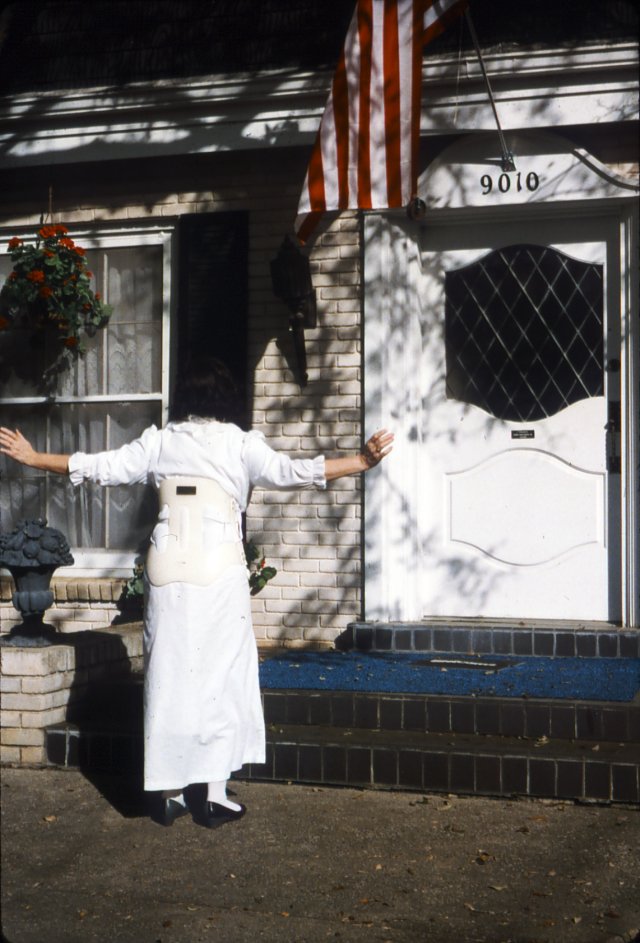
Erika was unable to return to her career in the operating
room after 1985
In some ways life became better since she had more free time for her family and
for me
This is us in Amsterdam in Year 2000
After 1985 she accompanied me on
my European lecture tours
Quite often we were then able to also visit her cherished relatives in Germany

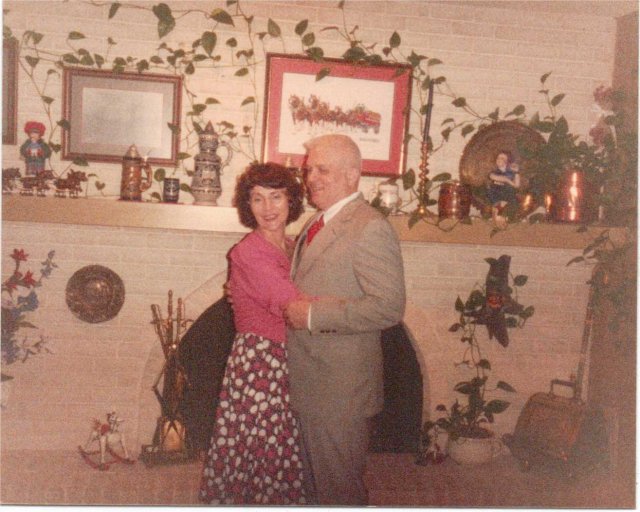
Here she's telling the Burgomaster of Munich in a reception
how she grew up as a Czech war refuge
and attended Munich's partially bombed out schools
Erika ended up in the USA after her mother married an American soldier

In the 1990s Erika had more spine surgeries at the South
Texas Spine Center
Dr. Meadows put in small metal plates with unbelievably long screws
In 2006 I retired from Trinity University, and we moved to
the
White Mountains in New Hampshire
http://www.trinity.edu/rjensen/NHcottage/NHcottage.htm
Shortly thereafter Erika had a couple of spine surgeries at
the Concord Hospital
Dr. Levy removed the old metal plates and replaced them with more modern metal
spine bracings
Here she is in a temporary harness after one of Dr. Levy's surgeries
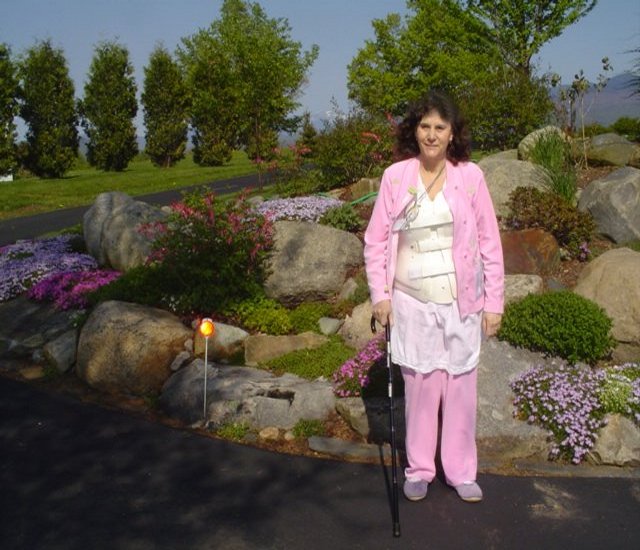
Several years later Erika ended up on Boston with Stephen
Parazin
Dr. Parazin is one of those super surgeons who's constantly followed by Harvard
Medical School surgical residents who trail behind him like puppies
Dr. Parazin's specialty is straightening bent spines, although he does other
types of complicated spine surgeries as well
His typical patient is an older woman (sometimes a man) in pain who can no
longer stand erect
Erika's first of several surgeries with him lasted over 14 hours in a New
England Baptist Center surgery room
Dr. Parazin literally broke her spine in three places and then reinforced it
with short rods
After healing she stood erect and could bend down to touch her toes
Spine surgeons provide hope of pain relief
But there are never any guarantees of pain relief, and invasive surgery should
probably be put off as long as possible
Erika's pain level increased with each of her 15 spine surgeries
Until May 13, 2016 Erika never had a spine surgery at the
Dartmouth-Hitchcock Medial Center
(DHMC) about a one hour drive from our cottage
She did, however, end up being treated for several years by an anesthesiologist
pain physician at the DHMC Pain Management Center
Her pain relief comes from ever-increasing dosages of
opiates such
as morphine
Erika never gets an addict's "high" from opiates but she's addicted to opiates
for pain relief
Along with opiates comes all the discomforts and medical treatments for awful
unwanted
side effects
Erika never babies herself, and that's become a problem
In spite of 15 spine surgeries she insists, among other things, on tending (with
my help) three flower gardens
I keep telling her to enjoy the gardens and let me do the gardening --- she
doesn't listen
Here she's sticking out her tongue at me when I pleaded for
her not to work in the flower gardens
She does not, however, shovel snow even though she posed for
this picture
In New Hampshire I had an elevator installed in our cottage
for Erika
Now it's simple to wheel grocery bags from the garage all the way to the
upstairs kitchen
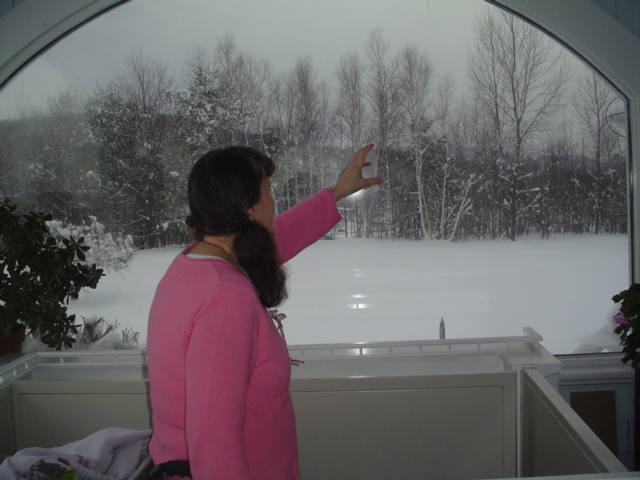
Sciatic Nerve --- https://en.wikipedia.org/wiki/Sciatic_nerve
Spinal Cord Simulator --- https://en.wikipedia.org/wiki/Spinal_cord_stimulator
Boston Scientific Spinal Cord Simulator
(BSSCS) ---
http://hcp.controlyourpain.com/
Also see
http://hcp.controlyourpain.com/why-boston-scientific/?s=compare
In February 2016 Erika's DHMC pain manager suggested that she go
across the hall to consult a long-time neurosurgeon named Dr. Ball
Dr. Ball later conducted various tests to investigate to possibility of
installing a spinal cord simulator for pain relief
It's important to note that such devices do not eliminate pain but are intended
to provide some pain relief, usually with the intent of cutting back on pain
relief medications
In Erika's case there was never a hard sell to install the spinal cord
simulator
In fact Dr. Ball was very pessimistic about being able to get the required
electrodes (leads) properly beneath all her spinal hardware and scar tissue
But Erika pleaded with him to try even though there was high probability he
could not properly install the leads and some (small) possibility of
non-reversible paralysis
On Friday May 13, 2016 Dr. Ball and his surgery team managed
to install (after over three hours of surgery) the electrodes wired to a
temporary BSSCS device
A temporary device is normally installed for at least a one day trial period
before the electrodes are fastened to a permanent BSSCS device in a second
surgery
Because of the weekend and difficulties of getting one of the very busy surgery
rooms at the DHMC Erika had three days in the hospital to test the BSSCS
Among her surgery team members was a BSCSC techie (woman) named Sidney who works
for the manufacturer of the device
On the day after the first surgery Sidney fine-tuned four programs for Erika on
Erika's temporary BSSCS
Program 1 for hips and buttocks
Program 2 for both legs
Program 3 for more intense stimulation to the left leg
Program 4 for more intense stimulation for the right leg
Users can change programs at any time with a remote control,
but Erika has always preferred Program 2
Users can also control stimulation intensity of any program with the remote control
After one day of testing Erika would have rejected installing the permanent
device because she found the stimulation too uncomfortable
After Day 2 she could not make up her mind
After Day 3 she decided there was most definitely satisfactory (albeit not
perfect) pain relief and elected to have the permanent device installed
In fairness nobody ever pressured Erika to
have the permanent device installed
In fact everybody involved, especially Sidney, kept telling Erika
not to have the permanent device
installed unless there was notable pain relief
On May 17, 2016 it took less than an hour in the operating
room to have Erika's permanent device installed
Unlike the temporary device, there are no wires protruding out of Erika's
surgical wound
The permanent device is all inside her backside
She has a belt with a disk that she's supposed to wear about an hour per month
until the interior battery is wirelessly recharged
She's not yet tried to use this recharging belt
The battery inside her body should last for years, and eventual replacement of
the device's battery entails only a simple surgery
Erika can use the remote control to turn the stimulation on
or off
Since Erika's second surgery she's never yet turned the stimulation
off
She sets the stimulation at a level where she can barely feel the stimulation
but has noteworthy pain relief
At times, especially when using the bathroom, she turns the stimulation
intensity down with the remote control
(Actually at home she simply leaves the remote control in her bathroom)
The instruction book advises turning the device off when driving a car (lawyers
probably insisted on that clause)
In the above links you can read about what the stimulation feels like
Erika can feel the stimulation all along her sciatic nerve from hips to heels
What at first was an uncomfortable feeling is now a comfortable feeling except
at higher intensities
She now hopes to commence cutting back slowly on the pain medications
There will be difficult opiate withdrawal symptoms as well as (hopefully) relief
from the unwanted side effects of opiates
Update: In May 2018 surgeons removed the useless
electronic pain stimulator and replaced it with a morphine pump.
The morphine pump is no magic bullet for pain relief, but for Erika it's much
better than the useless electronic device.
What are our worries?
Our first worry is that the pain relief Erika is getting now will not
last over time
It's beginning to look like pain relief will endure, but it's way too early to
tell for sure
We don't know whether pain spasms she experiences when sitting too long at
church or in a restaurant will return
There are Internet forums and testimonial sites, but
these can sometimes be biased and misleading
http://www.healthcentral.com/chronic-pain/c/question/71294/76385/
When it comes to sciatic nerve pain, every patient is unique in terms of
treatments and psychology
There's always a worry of accidentally moving the spinal cord electrodes,
but Dr. Ball tells her to live life normally as best she can
Normal even includes bending while pulling up weeds in her flower gardens (sigh)
One worry with the BSSCS device is that Erika will break a
rod in her spine because she has less warning pain (such as pain while
gardening)
Several years ago Erika somehow broke a rod (she's not actually sure when it
happened)
She eventually had to be taken in excruciating pain all the way to Boston
Instead of removing the broken rod Dr. Parazin installed additional rods
I'm told all the titanium in Erika is worth more at a junk yard than the price
of a new Mercedes
I tease her about checking on her value at the local recycling center
There are various other worries about the BSSCS device
that I won't go into here
For example, if Erika should ever need a pacemaker the BSSCS device would
possibly have to be removed in a somewhat difficult surgery
Certainly anybody considering having a BSSCS device should read all the warning
literature and the results of all the clinical trials
It tenuously appears for now that Erika can lead a normal life and pretty much ignore the BSSCS device turned on in her body 24/7 (maybe not when driving)
Is this device cost effective?
It's cost effective to us since Medicare and our Medicare premium supplemental insurance
(BC Anthem) will probably pay for everything
At this point I've no idea what the cost totals for the device installed ---
let's hypothetically assume $50,000
Worker Compensation insurance and Medicare insurance providers now have $1++ million dollars invested in
Erika's spine
$50,000 is peanuts compared to the what insurance companies have already
paid for Erika's surgeries and therapies to date
What accounting students should consider is the $50,000 (or
whatever) compared to the present value to Medicare of not having Erika's BSSCS
device installed
But such a comparison is almost impossible since it's impossible to know what
future medical expense would be incurred if Erika did not have such a device
We don't know how many MRI and other diagnostic future
savings will arise because she has device relieving her pain
We don't know how many future spine surgeries for Erika will be avoided because
she has such a device relieving her pain
We don't know how much pain therapy cost will be avoided because she has
the BSSCS device installed
We don't know how much medication costs will be reduced in her lifetime because
she has the BSSCS device installed
There are cost comparison studies in the clinical trials of
spinal cord stimulation devices
https://en.wikipedia.org/wiki/Spinal_cord_stimulator
A booklet comes with the device describing clinical trials on over a thousand
users
But these macro studies cannot tell us what Erika's particular BSSCS will cost
or save (net) in her particular case for the rest of her life
That's because her particular case is unique
For example, most spinal cord patients do not have as much hardware in their
spines or as much complicating scar tissue causing pain
Accounting and finance students will discover that cost comparisons of stimulation devices in general (spine, brain, Parkinson's, etc.) are very, very complicated.
What impresses me the most about her BSSCS device?
What impresses me the most is how electrodes that are not really hard-wired to
sciatic nerve endings can wirelessly connect to parts of that nerve
If Erika turns up the stimulator intensity she can feel sensations all along
that nerve from her hips down to her feet and most points along the way
It's an ingenious technology innovation that's evolved over decades of
engineering and medical research
It makes me wonder why it's still so difficult to restore mobility to paralyzed
people?
Every day since coming home Erika feels better about her
BSSCS device
However, to date two people sent me email messages about folks who are less
happy with other brands of such stimulators
If you are looking into getting a BSSCS gather up all the information you can from
people like Erika experienced in having a BSSCS
If you don't have sciatic nerve pain take care of your good fortune
My answer outdoors is a bucket loader on my tractor --- and an elevator indoors
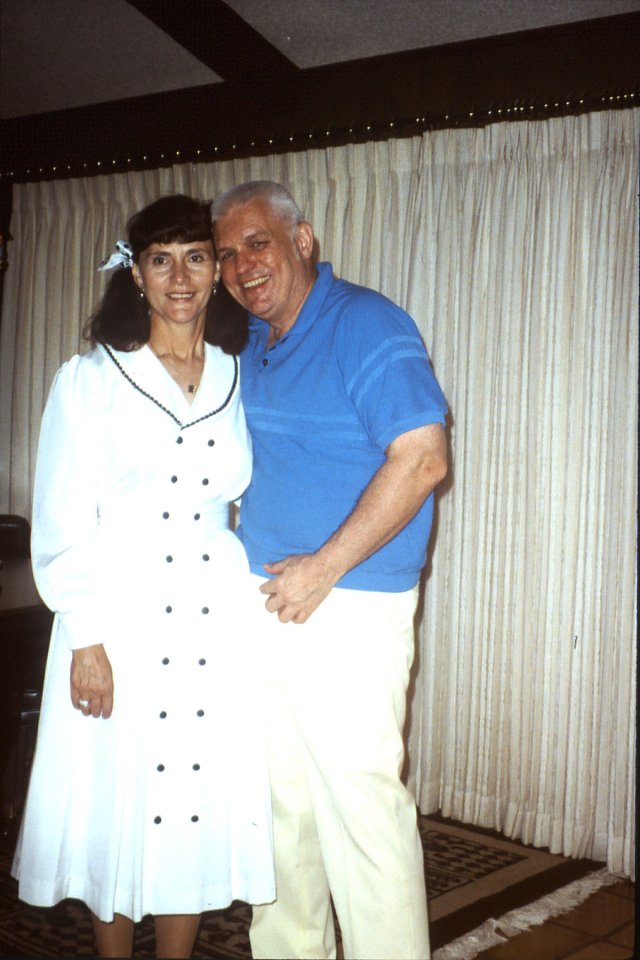
At Christmas time I hope to stand Erika outdoors in the dark (this avoids my having to decorate a tree with lights)
You can see pictures of some of our fondest memories
of Texas at
http://www.trinity.edu/rjensen/tidbits/2016/tidbits051116.htm
More of Bob Jensen's Pictures and
Stories (scroll down for "summertime" pictures of our flower gardens
and our wildflower field)
http://www.trinity.edu/rjensen/Pictures.htm
Summertime Favorites
Set 1 --- http://www.trinity.edu/rjensen/tidbits/SummertimeFavorites/Set01/2010Set01.htm
Set 2 --- http://www.trinity.edu/rjensen/tidbits/SummertimeFavorites/Set02/2010Set02.htm
Set 3 --- http://www.trinity.edu/rjensen/tidbits/SummertimeFavorites/Set03/2013Set03.htm
Set 4 --- http://www.trinity.edu/rjensen/Tidbits/SummertimeFavorites/Set04/2014Set04.htm
The Life Cycle of Our Peonies in 2012 ---
http://www.trinity.edu/rjensen/tidbits/Peonies/Set02/PeoniesSet02.htmThe Seasonal Life Cycle of Bob Jensen's Impatiens
Part 1: May-June
http://www.trinity.edu/rjensen/tidbits/Impatiens/ImpatiensSet01/ImpatiensSet01.htm
Erika's Roses and the Seasonal Life Cycle of Bob Jensen's Impatiens
Part 2: July-August
http://www.trinity.edu/rjensen/tidbits/Impatiens/ImpatiensSet02/ImpatiensSet02.htmPart 3: Life Cycle of Bob Jensen's Impatiens (dead and gone after the first freeze)
http://www.trinity.edu/rjensen/Tidbits/Impatiens/ImpatiensSet03/ImpatiensSet03.htmPart 4 Photographs of My Impatiens and Other Flowers of Summer
http://www.trinity.edu/rjensen/Tidbits/Impatiens/ImpatiensSet04/ImpatiensSet04.htmRoses --- Domestic
Set 1 of Erika's Roses --- http://www.trinity.edu/rjensen/tidbits/Roses/Domestic/Set01/DomesticRosesSet01.htm
Set 2 of Erika's Roses --- http://www.trinity.edu/rjensen/tidbits/Roses/Domestic/Set02/DomesticRosesSet02.htm
Roses --- Our Wild Roses
Set 1 of Wild Roses --- http://www.trinity.edu/rjensen/tidbits/Roses/Wild/Set01/WildRosesSet01.htm
Also see --- http://www.trinity.edu/rjensen/tidbits/2009/tidbits090807.htmSet 2 of Wild Roses --- http://www.trinity.edu/rjensen/tidbits/Roses/Wild/Set02/WildRosesSet02.htm
Also see --- http://www.trinity.edu/rjensen/tidbits/2009/tidbits090702.htm
Wildflowers
Wildflowers Set 1 --- http://www.trinity.edu/rjensen/Tidbits/Wildflowers/Set01/WildFlowersSet01.htm
Erika's Flowers of the Field --- http://www.trinity.edu/rjensen/tidbits/2008/tidbits080625.htm
A Walk Down Lovers Lane --- http://www.trinity.edu/rjensen/tidbits/2009/tidbits090623.htm
Texas Wildflowers Set 1 --- http://www.trinity.edu/rjensen/tidbits/Wildflowers/Texas/WildflowersTexas.htm
Texas Wildflowers Set 2 --- http://www.trinity.edu/rjensen/Tidbits/Wildflowers/Texas02/TexasWildflowersSet02.htm
Texas Wildflowers Set 3 --- http://www.trinity.edu/rjensen/Tidbits/Wildflowers/Texas03/TexasWildflowersSet03.htm
Also see my Texas wildflower pictures at ---
http://www.trinity.edu/rjensen/tidbits/Wildflowers/Texas/WildflowersTexas.htmLupine Favorites
Set 1 --- http://www.trinity.edu/rjensen/tidbits/Lupine/Set01/LupineSet01.htm
Set 2 --- http://www.trinity.edu/rjensen/tidbits/Lupine/Set02/LupineSet02.htm
Go Botany: Discover thousands of New England plants --- https://gobotany.newenglandwild.org/teaching/
Wild Cranberries --- http://www.trinity.edu/rjensen/tidbits/2009/tidbits090509.htm
Jensen Comment
On May 23, 2016 springtime is so late I'm not sure we will even have a
springtime in these mountains. Where's all this global warming I keep hearing
about?
On May 14,
2006 I retired from
Trinity University after a long and
wonderful career as an accounting professor in four universities. I was
generously granted "Emeritus" status by the Trustees of Trinity University. My
wife and I now live in a cottage in the White Mountains of New Hampshire ---
http://www.trinity.edu/rjensen/NHcottage/NHcottage.htm
Bob
Jensen's Blogs ---
http://www.trinity.edu/rjensen/JensenBlogs.htm
Current and past editions of my newsletter called New
Bookmarks ---
http://www.trinity.edu/rjensen/bookurl.htm
Current and past editions of my newsletter called
Tidbits ---
http://www.trinity.edu/rjensen/TidbitsDirectory.htm
Current and past editions of my newsletter called
Fraud Updates ---
http://www.trinity.edu/rjensen/FraudUpdates.htm
Bob Jensen's past presentations and lectures
---
http://www.trinity.edu/rjensen/resume.htm#Presentations
Our
address is 190 Sunset Hill Road, Sugar Hill, New Hampshire
Our cottage was known as the Brayton Cottage in the early 1900s
Sunset Hill is a ridge overlooking with
New Hampshire's White Mountains to the East
and Vermont's
Green Mountains to the West
Bob Jensen's Threads --- http://www.trinity.edu/rjensen/threads.htm
Bob Jensen's Home Page --- http://www.trinity.edu/rjensen/